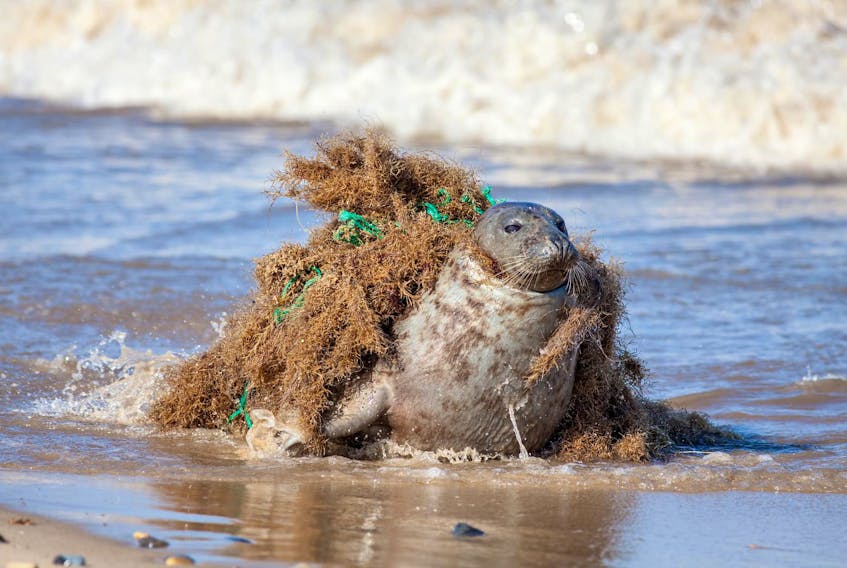LYNN KAVANAUGH
When it comes to marine plastic pollution, it’s fair to say the world has experienced a sudden awakening.
The result: an increase in government-led initiatives, efforts by civil society and commitments from the private sector to tackle the sources of this plastic waste and to remove what’s already there. Promises abound to eliminate plastic straws and disposable cups, and to increase recycled plastics manufacturing.
Canada, too, has stepped up. At last year’s G7 meeting, our government introduced the ocean plastic charter. Five of the seven G7 countries signed on, and since then, many more have done so, along with several companies and NGOs.
The charter takes a multi-pronged approach, which includes working with industries to escalate plastic reuse and recycling, explore alternatives, promote education efforts, and support coastal and shoreline cleanups. The latter also acknowledges waste from abandoned, lost and otherwise discarded fishing gear (also called “ghost gear”), a lesser-known but significant source of ocean plastic pollution.
The United Nations Environment Programme (UNEP), for example, estimates that 640,000 tons of ghost gear ends up in our oceans each year, which is about 10 per cent of the volume of marine litter. Recent research found a whopping 46 per cent of the plastic in the “Great Pacific Garbage Patch” is fishing nets.
Even more significant is the fact that this gear is one of the deadliest forms of marine litter. A 2016 study published in Marine Policy by Wilcox et al. found fishing-related gear (along with balloons and plastic bags) to pose the greatest entanglement risk to marine wildlife such as seabirds, sea turtles and marine mammals. These animals often die a slow and painful death when they’re caught in fishing gear as they are unable to free themselves — as happened last year when several seals died from entanglement in a net in the Fraser River off the B.C. coast.
And, of course, ghost gear kills fish, too. A study at the Virginia Institute of Marine Sciences found that 1.25 million blue crabs caught in ghost crab pots in Virginia Bay in 2013 had a value of more than $400,000. Such significant losses have implications for food security, too, since fishing is an important source of food, nutrition, income and livelihood for hundreds of millions of people around the world.

Following on from the G7 meeting, at the G7 Ocean Partnership Summit last September, Canada also became a signatory to the Global Ghost Gear Initiative (GGGI), a multi-stakeholder platform to address the causes of ghost gear and develop solutions. To date, over 100 organizations and companies, along with 14 governments, are participants in the GGGI, and solution projects are taking place in regions across the globe, including China and Indonesia. Several local projects are also underway in Canada — Fundy North Fishermen’s Association, Rendezvous Dive Adventures and Emerald Sea Protection Society, to name a few.
Despite the compelling evidence and increasing profile of this issue, few Canadian seafood companies have signed onto the GGGI and most are largely silent on the topic of ghost gear altogether.
Case in point: World Animal Protection’s report, Ghosts Beneath the Waves, published earlier this year, assessed 25 of the largest seafood companies around the world on their seafood sustainability commitments, including those addressing the problem of lost and abandoned fishing gear. Three Canadian companies were assessed — Clearwater Seafoods, Cooke Aquaculture and High Liner Foods — and all ranked poorly (though High Liner did improve by one tier since last year).
Ironically, this report emerged shortly after Clearwater was caught and fined for leaving thousands of lobster pots in the ocean for an extended period.
Seafood companies, however, are well-positioned to implement best practices to reduce and mitigate the harms of ghost gear as part of their sustainable seafood policies. And it’s in their best interest to do so — with many fish stocks already overfished, the ghost fishing burden can be significant.
Fishing is global business, with companies sourcing in one region, and processing and selling in another. Marine litter, too, is a global phenomenon, since ocean pollution doesn’t recognize geographic boundaries. With concerns about ocean plastic pollution gaining traction and growing consumer awareness about microplastics in their food, it’s just a matter of time before they begin to hold companies more accountable on this issue.
Now it is time for the fishing industry to take action on ghost gear, for the sake of ocean health, marine animals and livelihoods.
Lynn Kavanagh is an oceans and wildlife campaign manager for World Animal Protection, Canada.
RELATED:









